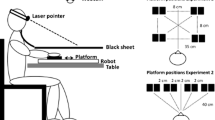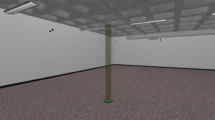Abstract
The experience of the body as a single coherent whole is based on multiple local sensory signals, integrated across different sensory modalities. We investigated how local information is integrated to form a single body representation and also compared the contribution of proprioceptive and visual information both in expert dancers and non-dancer controls. A number of previous studies have focused on individual differences in proprioceptive acuity at single joints and reported inconsistent findings. We used the established endpoint position matching task to measure absolute and directional errors in matching the position of one hand with the other. The matching performance was tested in three different conditions, which involved different information about the target position: only proprioceptive information from a ‘target’ hand which could be either the left or the right, only visual information, or both proprioceptive and visual information. Differences in matching errors between these sensory conditions suggested that dancers show better integration of local proprioceptive signals than non-dancers. The dancers also relied more on proprioception when both proprioceptive and visual information about hand position were present.




Similar content being viewed by others
References
Adamo DE, Martin BJ (2009) Position sense asymmetry. Exp Brain Res 192:87–95
Ashton-Miller JA, Wojtys EM, Huston LJ, Fry-Welch D (2001) Can proprioception really be improved by exercises? Knee Surg Sports Traumatol Arthrosc 9:128–136
Bagesteiro LB, Sainburg RL (2003) Nondominant arm advantages in load compensation during rapid elbow joint movements. J Neurophysiol 90:1503–1513
Barrack RL, Skinner HB, Cook SD (1984) Proprioception of the knee joint. Paradoxical effect of training. Am J Phys Med 63:175–181
Dragovic M (2004) Towards an improved measure of the Edinburgh Handedness Inventory: a one-factor congeneric measurement model using confirmatory factor analysis. Laterality 9:411–419
Ernst MM, Banks MS (2002) Humans integrate visual and haptic information in a statistically optimal fashion. Nature 415:429–433
Ferrell WR, Smith S (1988) Position sense at the proximal interphalangeal joint of the human index finger. J Physiol 399:49–61
Fourkas AD, Ionta S, Aglioti SM (2006) Influence of imagined posture and imagery modality on corticospinal excitability. Behav Brain Res 168:190–196
Gandevia SC (1996) Kinesthesia: roles for afferent signals and motor commands. In: Rowell LB, Shepherd JT (eds) Handbook of physiology section 12. Exercise: regulation and integration of multiple systems. Oxford University Press, Oxford, pp 128–172
Goble DJ, Brown SH (2008) The biological and behavioral basis of upper limb asymmetries in sensorimotor performance. Neurosci Biobehav Rev 32:598–610
Goble DJ, Coxon JP, Wenderoth N, Van Impe A, Swinnen SS (2009) Proprioceptive sensibility in the elderly: degeneration, functional consequences and plastic-adaptive processes. Neurosci Biobehav Rev 33:271–278
Golomer E, Dupui P (2000) Spectral analysis of adult dancers’ sways: sex and interaction vision-proprioception. Int J Neurosci 105:15–26
Graziano MSA, Botvinick MM (2002) How the brain represents the body: insights from neurophysiology and psychology. In: Prinz W, Hommel B (eds) Common mechanisms in perception and action: attention and performance XIX. Oxford University Press, Oxford, pp 136–157
Haggard P, Newman C, Blundell J, Andrew H (2000) The perceived position of the hand in space. Percept Psychophys 62:363–377
Jones SAH, Cressman EK, Henriques DYP (2010) Proprioceptive localization of the left and right hands. Exp Brain Res 204:373–383
Kuni B, Schmitt H (2004) Peak torque and proprioception at the ankle of dancers in professional training [Article in German]. Sportverletz Sportschaden 18:15–21
Lephart SM, Giraldo JL, Borsa PA, Fu FH (1996) Knee joint proprioception: a comparison between female intercollegiate gymnasts and controls. Knee Surg Sports Traumatol Arthrosc 4:121–124
Loomis JM, Lederman SJ (1986) Tactual perception. In: Boff K, Kaufman L, Thomas J (eds) Handbook of perception and human performance, vol 2. Wiley, New York, pp 31–41
Marmeleira JF, Pereira C, Cruz-Ferreira A, Fretes V, Pisco R, Fernandes OM (2009) Creative dance can enhance proprioception in older adults. J Sports Med Phys Fitness 4:480–485
Mitson L, Ono H, Barbeito R (1976) Three methods of measuring the location of the egocentre: their reliability, comparative locations and intercorrelations. Can J Psychol 30:1–8
Mon-Williams MA, Wann JP, Pascal E (1999) Visual-proprioceptive mapping in children with developmental coordination disorder. Dev Med Child Neurol 41:247–254
Mouchnino L, Aurenty R, Massion J, Pedotti A (1993) Is the trunk a reference frame for calculating leg position? Neuroreport 4:125–127
Nardini M, Begus M, Manning C, Mareschal D (2010) Integration for visual and proprioceptive cues to hand position in development. Perception 39:146
Petrini K, Dahl S, Rocchesso D, Waadeland CH, Avanzini F, Pruce A, Pollick FE (2009a) Multisensory integration of drumming actions: musical expertise affects perceived audiovisual asynchrony. Exp Brain Res 198:339–352
Petrini K, Russell M, Pollick FE (2009b) When knowing can replace seeing in audiovisual integration of actions. Cognition 110:432–439
Radell SA, Adame DD, Cole SP (2003) Effect of teaching with mirrors on ballet dance performance. Percept Mot Skills 97:960–964
Ramsay JR, Riddoch MJ (2001) Position-matching in the upper limb: professional ballet dancers perform with outstanding accuracy. Clin Rehabil 15:324–330
Schmitt H, Kuni B, Sabo D (2005) Influence of professional dance training on peak torque and proprioception at the ankle. Clin J Sport Med 15:331–339
Shabbott BA, Sainburg RL (2008) Differentiating between two models of motor lateralization. J Neurophysiol 100:565–575
Shabbott BA, Sainburg RL (2010) Learning a visuomotor rotation: simultaneous visual and proprioceptive information is crucial for visuomotor remapping. Exp Brain Res 203:75–87
Sherrington CS (1907) On the proprio-ceptive system, especially in its reflex aspect. Brain 29:467–482
Sims K, Morton J (1998) Modelling the training effects of kinaesthetic acuity measurement in children. J Child Psychol Psychiatry 39:731–746
Swinnen SP, Wenderoth N (2004) Two hands, one brain: cognitive neuroscience of bimanual skill. Trends Cogn Sci 8:18–25
Van Beers RJ, Wolpert DM, Haggard P (2002) When feeling is more important than seeing in sensorimotor adaptation. Curr Biol 12:834–837
Von Hofsten C, Rösblad B (1988) The integration of sensory information in the development of precise manual pointing. Neuropsychologia 26:805–821
Vuillerme N, Teasdale N, Nougier V (2001) The effect of expertise in gymnastics on proprioceptive sensory integration in human subjects. Neurosci Lett 311:73–76
Wann JP (1991) The integrity of visual-proprioceptive mapping in cerebral palsy. Neuropsychologia 29:1095–2106
Wolpert DM, Ghahramani Z (2000) Computational principles of movement neuroscience. Nat Neurosci 3:1212–1218
Acknowledgments
This research was supported by a researchers’ fellowship to CJ 106258 from the Swiss National Foundation (current affiliation Department of Psychology, University of Surrey, UK). Additional support was provided by The Leverhulme Trust, Research Grant F/07/134/AO to PH. We thank Dr Laura Brown for the help with the manuscript and Roger Bunce for technical support.
Author information
Authors and Affiliations
Corresponding author
Electronic supplementary material
Below is the link to the electronic supplementary material.
Rights and permissions
About this article
Cite this article
Jola, C., Davis, A. & Haggard, P. Proprioceptive integration and body representation: insights into dancers’ expertise. Exp Brain Res 213, 257–265 (2011). https://doi.org/10.1007/s00221-011-2743-7
Received:
Accepted:
Published:
Issue Date:
DOI: https://doi.org/10.1007/s00221-011-2743-7




